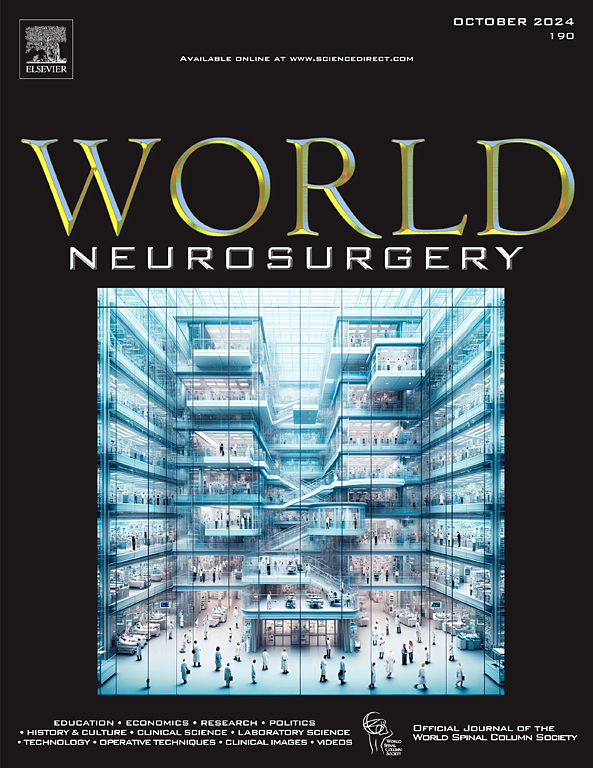术中应用地塞米松改善肘管综合征减压术的近期疗效。
IF 1.9
4区 医学
Q3 CLINICAL NEUROLOGY
引用次数: 0
摘要
目的:评价术中应用地塞米松对肘管综合征(CuTS)减压术后短期临床疗效的影响及其对术后炎症的控制作用。方法:根据术中治疗记录将114例重度切口患者分为研究组(55例)和对照组(59例)。研究组在尺神经减压后,在神经外膜注射地塞米松10 mg。术后恢复评估采用视觉模拟量表(VAS)、PRUNE评分、改良Bishop评分、两点辨别和肌电图。结果:研究组术后4周恢复明显优于对照组。VAS评分由4.69±0.95降至3.56±0.88,PRUNE评分由51.38±9.79降至40.87±7.82 (p=0.045)。4周时,研究组的改良Bishop评分为8.69±1.18,对照组为7.49±0.88 (p讨论:术中地塞米松可显著减轻炎症和水肿,促进CuTS患者神经功能更快恢复。尽管6个月时差异逐渐减小,但研究结果强调地塞米松是改善短期术后结果的安全有效的选择。本文章由计算机程序翻译,如有差异,请以英文原文为准。
Improving Short-Term Outcomes of Cubital Tunnel Syndrome Decompression with Intraoperative Dexamethasone
Objective
To evaluate the effect of intraoperative dexamethasone on short-term clinical outcomes following decompression procedures for cubital tunnel syndrome (CuTS) and its role in controlling postoperative inflammation.
Methods
A retrospective analysis was conducted on 114 patients with severe CuTS, categorized into a dexamethasone group (n=55) and a control group (n=59). All patients underwent anterior ulnar nerve transposition. The dexamethasone group received 10 mg of dexamethasone injected subepineurally after decompression. Outcomes were assessed at 4 weeks and 6 months postoperatively using visual analog scale, patient-reported ulnar nerve evaluation, Modified Bishop score, two-point discrimination, and electromyography.
Results
At 4 weeks, the dexamethasone group showed significantly better improvements in visual analog scale (3.56 ± 0.88 vs. 4.03 ± 0.99, P = 0.014), patient-reported ulnar nerve evaluation (40.87 ± 7.82 vs. 43.49 ± 7.16, P = 0.045), and Bishop scores (8.69 ± 1.18 vs. 7.49 ± 0.88, P < 0.001) compared to the control group. Electrophysiological testing at 6 months also revealed higher motor nerve conduction velocity (50.04 ± 3.92 vs. 46.49 ± 4.84 m/s, P < 0.001) and sensory nerve conduction velocity (49.06 ± 4.60 vs. 47.10 ± 5.63 m/s, P = 0.041) in the dexamethasone group. No adverse effects were observed.
Conclusions
Intraoperative dexamethasone effectively reduces inflammation and edema, promoting early nerve recovery and improved short-term outcomes in CuTS decompression. It is a safe and effective adjunctive treatment strategy.
求助全文
通过发布文献求助,成功后即可免费获取论文全文。
去求助
来源期刊

World neurosurgery
CLINICAL NEUROLOGY-SURGERY
CiteScore
3.90
自引率
15.00%
发文量
1765
审稿时长
47 days
期刊介绍:
World Neurosurgery has an open access mirror journal World Neurosurgery: X, sharing the same aims and scope, editorial team, submission system and rigorous peer review.
The journal''s mission is to:
-To provide a first-class international forum and a 2-way conduit for dialogue that is relevant to neurosurgeons and providers who care for neurosurgery patients. The categories of the exchanged information include clinical and basic science, as well as global information that provide social, political, educational, economic, cultural or societal insights and knowledge that are of significance and relevance to worldwide neurosurgery patient care.
-To act as a primary intellectual catalyst for the stimulation of creativity, the creation of new knowledge, and the enhancement of quality neurosurgical care worldwide.
-To provide a forum for communication that enriches the lives of all neurosurgeons and their colleagues; and, in so doing, enriches the lives of their patients.
Topics to be addressed in World Neurosurgery include: EDUCATION, ECONOMICS, RESEARCH, POLITICS, HISTORY, CULTURE, CLINICAL SCIENCE, LABORATORY SCIENCE, TECHNOLOGY, OPERATIVE TECHNIQUES, CLINICAL IMAGES, VIDEOS
 求助内容:
求助内容: 应助结果提醒方式:
应助结果提醒方式:


